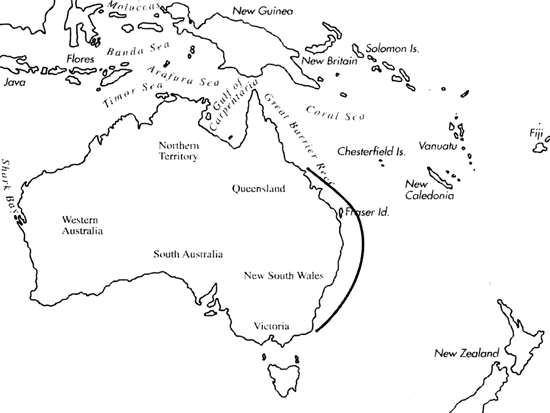
Skip Navigation Links
View access keys for this site.

Range: New South Wales and S. Queensland, Australia.
Description: Small to moderately small, light to moderately solid. Last whorl ventricosely conical to broadly and ventricosely conical; outline convex adapically, straight toward base; left side may be concave near base. Shoulder angulate to rounded. Spire of low to moderate height, outline straight to sigmoid. Teleoconch sutural ramps flat to slightly concave; 3 increasing to 5-8 variably fine spiral grooves on late ramps. Last whorl with rather widely spaced distinct spiral ribs on basal third to half.
| Shell Morphometry | ||
|---|---|---|
| L | 20-27 mm | |
| RW | 0.05-0.13 g/mm | |
| RD | 0.62-0.73 | |
| PMD | 0.75-0.85 | |
| RSH | 0.09-0.14 | |
Ground colour greyish to light blue. Last whorl with 2-5 (usually 3) variably broad, olive to brown or pink spiral bands. Variably spaced spiral rows of small to large squarish brown dots extending from base to shoulder, sometimes reduced and often with intermittent greyish to bluish white dashes. Postnuclear sutural ramps with brown wavy radial lines and streaks, sometimes extending over shoulder. Aperture brownish or dark violet behind a translucent marginal zone, with a pale band at centre and shoulder.
Periostracum yellowish to brownish olive, rather thin, translucent to opaque, rough.
Foot, rostrum and siphon white, speckled with black.
Radular teeth with an adapical barb opposite a weak blade; weak serration present (Bergh, 1895).
Habitat and Habits: In shallow water; under rocks.
Discussion: C. aplustre is similar to C. papilliferus in shape and sculpture. The latter species is often larger and less straight in outline. Its last whorl pattern lacks spiral colour bands but has olive to dark brown axial markings, and the dotted spiral lines are more often incomplete or absent; its last whorl sculpture is less prominent, and its periostracum has spiral rows of tufts. The animals have a quite different colouration. C. cooki may be a colour form with reticulated red-brown axial lines and streaks but without spiral rows of dots. However, its assignment to C. aplustre remains doubtful mainly on account of its slightly more conical last whorl.

C. aplustre range map
This section contains verbatim reproductions of the accounts of 316 species of Conus from the Indo-Pacific region, from Manual of the Living Conidae, by Röckel, Korn and Kohn (1995). They are reproduced with the kind permission of the present publisher, Conchbooks.
All plates and figures referred to in the text are also in Röckel, Korn & Kohn, 1995. Manual of the Living Conidae Vol. 1: Indo-Pacific Region.
The range maps have been modified so that each species account has it own map, rather than one map that showed the ranges of several species in the original work. This was necessary because each species account is on a separate page on the website and not confined to the order of accounts in the book.
Return to framed version (returns to search page)